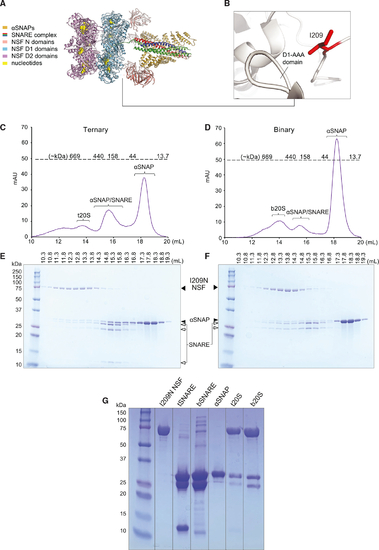Figure 6.
- ID
- ZDB-FIG-231002-67
- Publication
- Gao et al., 2023 - Sensory deficit screen identifies nsf mutation that differentially affects SNARE recycling and quality control
- Other Figures
- All Figure Page
- Back to All Figure Page
|
I209N NSF-αSNAP form complexes with either ternary or binary neuronal SNARE complexes (A) Cryo-EM structure of NSF 20S complex (PDB: 6MDM). (B) N-D1 linker region. I209 is shown as a red stick model. (C) Size-exclusion chromatography (SEC) profile of t20S consisting of I209N NSF, ternary (syntaxin-1A-SNAP-25-synaptobrevin-2) SNARE complex (tSNARE), and αSNAP mixed in 1:5:25 M ratios. Predicted molecular weights for the SEC are indicated above the dotted line. (D) SEC of b20S consisting of I209N NSF, binary (syntaxin-1A-SNAP-25) SNARE complex (bSNARE), and αSNAP mixed in 1:5:25 M ratios. (E) SDS-PAGE gel of fractions from SEC of t20S. The elution volumes are indicated above the gel. (F) SDS-PAGE of protein ladder and gel fractions from SEC of b20S. (G) SDS-PAGE gel of protein ladder, NSF stock, tSNARE, bSNARE, αSNAP, t20S filtered through a 100k MWCO concentrator, and b20S filtered through a 100k MWCO concentrator. SEC peaks are typical of a 20S complex preparation with WT NSF. |

